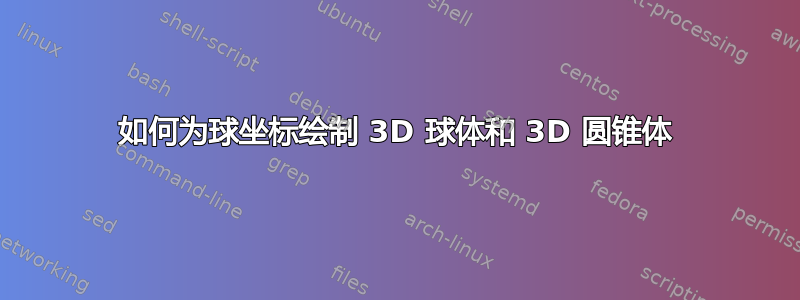
我正在尝试复制这个数字:
现在,我有这个代码:
\begin{figure}[H]
\centering
\begin{tikzpicture}[yzx, scale = 0.9]
\draw[->] (0,0,0) -- (5.5,0,0) node(x)[left]{$x$};
\draw[->] (0,0,0) -- (0,5,0) node(y)[right]{$y$};
\draw[->] (0,0,0) -- (0,0,4) node(z)[right]{$z$};
\def\px{4}; \def\py{4}; \def\pz{4};
\coordinate (o) at (0,0,0);
\coordinate (p) at (\px,\py,\pz);
\coordinate (pxy) at (\px,\py,0);
% Spherical coordinates
\begin{scope}[canvas is xy plane at z=0]
\draw[->, cadmiumorange] (2,0) arc(0:45:2) node[pos = 0.5, below]{$\phi$};
\draw[dotted, cadmiumorange] (o) -- (pxy);
\end{scope}
\draw[cadmiumorange] (o) -- (p) node[above left, pos = 0.5]{$r$};
\draw[dotted] (pxy) -- (p) node[pos = 0.5, right]{$z$};
\begin{scope}[canvas is zy plane at x=0]
\draw[->, cadmiumorange] (1,0) arc(0:45:1) node[pos = 0.5, above]{$\theta$};
\end{scope}
% x-y-z coordinates
\draw[bleudefrance] (o) -- (\px,0,0) node[above, pos = 0.5, sloped]{$x$};
\draw[bleudefrance] (\px,0,0) -- (pxy) node[pos = 0.5, below]{$y$};
% Point
\filldraw (p) circle(3pt)
node[above right]{$P(r, \theta, \phi)$}
node[below right]{$P(x,y,z)$};
\end{tikzpicture}
\caption{Coordenadas cartesianas y esf\'ericas.}
\label{c2:definiciones:esfericasB}
\end{figure}
产生
这就是我自己能画的全部了。我不知道如何画这个“立体”球体和圆锥体。第一个图中的文字是西班牙语,但答案中不需要它。
这个问题的理想答案是类似于这个问题的答案:如何绘制参考圆柱坐标的立体图形。这个答案(相对)容易理解和修改。
我的代码中也有这个:
\documentclass[11pt, oneside]{book}
\usepackage{pgfplots}
\pgfplotsset{compat = newest}
\usepackage{tikz-3dplot}
\usepackage{tikz}
\usetikzlibrary{snakes, calc, quotes, babel, hobby, trees, arrows, patterns, patterns.meta, calligraphy, backgrounds, chains, shapes.geometric, shapes, angles, 3d, fillbetween,
decorations, decorations.pathreplacing,
decorations.pathmorphing, decorations.markings, decorations.text}
\tikzstyle{yzx} = [
x={(-.385cm, -.385cm)},
y={(1cm, 0cm)},
z={(0cm, 1cm)},
]
\tikzset{zxplane/.style={canvas is zx plane at y=#1,very thin}}
\tikzset{yxplane/.style={canvas is yx plane at z=#1,very thin}}
\usepackage{tkz-euclide}
\tikzset{every picture/.style = {line width = 1pt, > = Triangle},
%
%
%
set arrow inside/.code = {\pgfqkeys{/tikz/arrow inside}{#1}},
set arrow inside={end/.initial = >, opt/.initial =},
/pgf/decoration/Mark/.style = {
mark/.expanded = at position #1 with {
\noexpand\arrow[\pgfkeysvalueof{/tikz/arrow inside/opt}]{\pgfkeysvalueof{/tikz/arrow inside/end}}
}
},
arrow inside/.style 2 args = {
line width = 2pt,
set arrow inside = {#1},
postaction = {
decorate, decoration={
markings, Mark/.list = {#2}
}
}
},
}
\usepackage{physics}
\usepackage[italic = true]{derivative}
\usepackage[scr = rsfso]{mathalfa}
\usepackage{mathtools}
\usepackage{amssymb}
\definecolor{cadmiumorange}{rgb}{0.93, 0.53, 0.18}
感谢您的阅读并继续帮助!
答案1
canvas is...您可以使用库中的选项绘制类似于图片的内容3d。例如:
\tikzset
{
xz/.style={canvas is xz plane at y=0},
xz rotated/.style={rotate around z=\mytheta,xz},
}
这里我定义了两种样式。第一种在 xz 平面上绘制(如果你选择不同的,y则在距离 的平行平面上绘制y)。第二种在另一个平面上绘制,获得围绕 z 轴旋转 xy 平面的\mytheta度数(定义为 60)。
使用这些新平面,您只需要绘制几条直线和几个圆弧,它们都与角度\mytheta和相关\myphi。
一个完整的例子(好吧......我为你留下了标签)可能是:
\documentclass[tikz,border=2mm]{standalone}
\usetikzlibrary{3d} % for 'canvas is...' options
\tikzset
{% styles
axis/.style={thick,-latex},
yz/.style={canvas is yz plane at x=0},
xz/.style={canvas is xz plane at y=0},
xz rotated/.style={rotate around z=\mytheta,xz},
xy elevated/.style={canvas is xy plane at z={\myradius*cos(\myphi)},scale={sin(\myphi)}},
sphere/.style={shading=ball,fill opacity=0.3},
plane/.style={fill=teal,fill opacity=0.3},
cone/.style={fill=yellow,fill opacity=0.3},
vector/.style={very thick,-stealth},
point/.style={shading=ball,ball color=red}
}
\begin{document}
\begin{tikzpicture}[line cap=round,line join=round,
x={(-0.4cm,-0.4cm)}, y={(1cm,0)},z={(0,1cm)}]
% dimensions
\def\myradius{5}
\def\mytheta{60}
\def\myphi{30}
% axes
\draw[axis] (0,0,0) -- (1.3*\myradius,0,0) node[below] {$x$};
\draw[axis] (0,0,0) -- (0,1.3*\myradius,0) node[right] {$y$};
\draw[axis] (0,0,0) -- (0,0,1.3*\myradius) node[above] {$z$};
% sphere
\draw[sphere] (0,\myradius,0) {[yz] arc (0:90:\myradius)} {[xz rotated] arc (90:0:\myradius)} arc (\mytheta:90:\myradius);
% plane
\draw[plane,xz rotated] (0,\myradius) arc (90:0:\myradius) -| cycle;
% cone
\draw[cone] {[xy elevated] (\myradius,0) arc (0:\mytheta:\myradius) coordinate (P)} -- (0,0,0) -- cycle;
% other arcs
\draw (\mytheta:\myradius) arc (\mytheta:0:\myradius) {[xz] arc (0:90:\myradius)};
\draw[-latex] (1,0,0) arc (0:\mytheta:1) node[midway,below] {$\theta$};
\draw[xz rotated,-latex] (0,2) arc (90:90-\myphi:2) node[midway,above] {$\varphi$};
% vectors
\draw[xz rotated ,vector] (P) --++ (90-\myphi:1.5) node[above] {$\hat{r}$};
\draw[xz rotated ,vector] (P) --++ (-\myphi:1.5) node[right] {$\hat{\theta}$};
\draw[xy elevated,vector] (P) --++ (90+\mytheta:3) node[right] {$\hat{\varphi}$};
% point
\fill[point] (P) circle (0.1cm);
\end{tikzpicture}
\end{document}





